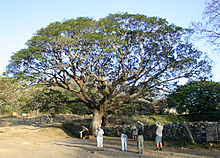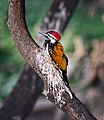Samanea saman
| Samanea saman | |
|---|---|

| |
| In Guanacaste, Costa Rica. | |
| Scientific classification | |
| Kingdom: | |
| (unranked): | |
| (unranked): | |
| (unranked): | |
| Order: | |
| Family: | |
| Genus: | |
| Species: | A. saman
|
| Binomial name | |
| Albizia saman | |
| Synonyms | |
|
Many, see text | |
Albizia saman (sometimes treated under the obsolete name Samanea saman) is a species of flowering tree in the pea family, Fabaceae, that is native to the Neotropics. Its range extends from Mexico south to Peru and Brazil, but it has been widely introduced to South and Southeast Asia, as well as the Pacific Islands, including Hawaii. Common names include saman, rain tree and monkeypod (see also below). It is often placed in the genus Samanea,[1] which by yet other authors is subsumed in Albizia entirely.
Description

Kolkata, West Bengal (India).
Saman is a wide-canopied tree with a large symmetrical crown. It usually reaches a height of 25 m (82 ft) and a diameter of 40 m (130 ft).[2] The leaves fold in rainy weather and in the evening, hence the name "rain tree" and "five o'clock tree" (Pukul Lima) in Malay. Several lineages of this tree are available, e.g., with reddish pink and creamish golden colored flowers.

|thumb|right|A giant specimen near Kanchanaburi, Thailand, known locally as chamchuri-yak (จามจุรียักษ์). "Chamchuri" is the Thai name of the the tree species, whereas "yak" is the Thai pronunciation of yaksha, a mythical demon, referring in this context to the monstrous size of the tree.]]
During his 1799–1804 travels in the Americas, Alexander von Humboldt encountered a giant saman tree near Maracay, Venezuela. He measured the circumference of the parasol-shaped crown at 576 ft (about 180.8 m[3]), its diameter was around 190 ft (about 59.6 m), on a trunk at 9 ft (about 2.8 m) in diameter and reaching just 60 ft (nearly 19 m) in height. Humboldt mentioned the tree was reported to have changed little since the Spanish colonization of Venezuela; he estimated it to be as old as the famous Canary Islands dragon tree (Dracaena draco) of Icod de los Vinos on Tenerife.[4]
The tree, called Samán del Guère (transcribed Zamang del Guayre by von Humboldt) still stands today, and is a Venezuelan national treasure. Just like the dragon tree on Tenerife, the age of the saman in Venezuela is rather indeterminate. As von Humboldt's report makes clear, according to local tradition, it would be older than 500 years today, which is rather outstanding by the genus' standards. It is certain, however, the tree is quite more than 200 years old today, but it is one exceptional individual; even the well-learned von Humboldt could not believe it was actually the same species as the saman trees he knew from the greenhouses at Schönbrunn Castle.[5]
Large branches of the tree tend to break off, particularly during rainstorms. This can be hazardous as the tree is very commonly used for avenue plantation.
Gallery
-
Black-rumped flameback (Dinopium benghalense) on rain tree bark
Kolkata, West Bengal (India) -
Pods
Kolkata, West Bengal, India -
Mature Bark
-
Cut wood
-
Rain Tree Flower
Names
Albizia saman is a well-known tree, rivalled perhaps only by lebbeck and pink siris among its genus. It is well represented in many languages and has numerous local names in its native range. Most names that originated in Europe (where the tree hardly grows at all) are some variety of "rain tree". The original name, saman - known in many languages and used for the specific epithet - derives from zamang, meaning "Mimosoideae tree" in some Cariban languages of northern Venezuela.[5]
The name "rain tree" was coined in tropical India, especially Bengal. Its origin is the moisture that collects on the ground under the tree, largely the honeydew-like discharge of cicadas feeding on the leaves.
- English: saman, rain tree, monkey pod, giant thibet, inga saman,[6] cow tamarind,[7] East Indian walnut,[8] soar, suar.
- Spanish: cenízaro, acacia preta, árbol de lluvia (rain tree), genízaro
- Cuba: algarrobo
- Central America: carreto, cenicero, dormilon, genizaro, zarza
- Colombia: campano, saman
- Venezuela: carabeli, couji, lara, urero, zaman
- German: Regenbaum (rain tree), Soar, Suar
- Sanskrit: Shiriisha
- Telugu: nidra ganneru తెలుగు
- Marathi: shirish
- Gujarati: shirish
- Tamil: thoongu moonji maram தூங்குமூஞ்சி மரம் (tree with a sleeping face);
- French: arbre à (la) pluie (rain tree)
- Haitian Creole: guannegoul(e)
- Hindi: vilaiti siris सीरस
- Bengali: shirish
- Kannada: Bhagaya mara
- Jamaica: goango, guango
- Javanese: trembesi
- Khmer ampil barang (French tamarind)
- Malagasy: bonara(mbaza), kily vazaha, madiromany, mampihe, mampohehy
- Indonesian/Malay: pukul lima (five o'clock tree, in Malaysia), pokok hujan (rain tree)
- Malayalam: chakkarakkay maram ചക്കരക്കായ് മരം
- Portuguese: chorona
- Sinhalese: mara
- Sundanese: ki hujan (rain tree)
- Trinidad: Samaan Tree
- Vietnamese: còng, muồng tím, cây mưa (rain tree)
- Thai: จามจุรี [dsha:m-dshu-ri:] jamjuree
In the Caribbean region, it is occasionally called marsave.
As an introduced plant on Fiji, it is called in some regions vaivai (ni vavalagi), from vaivai "watery" (in allusion to the tree's "rain") + vavalagi "foreign". In some parts of Vanua Levu, Fiji the word vaivai is used to describe the lebbeck, because of the sound the seedpods make, and the word mocemoce (sleepy, or sleeping) is used for A. saman due to the 'sleepiness' of its leaves.
Synonyms
Unlike some other Ingeae, its taxonomy was always rather straightforward. Though it has a lot of junior synonyms, it was little confused with other species, and unlike some others of its genus, has just one homonym:[9]
- Acacia propinqua A.Rich.
- Acacia propinqua Pedley is a synonym of Acacia mimula
- Albizzia saman (Jacq.) Merr. (orth.var)
- Calliandra saman (Jacq.) Griseb.
- Enterolobium saman (Jacq.) Prain
- Feuilleea saman (Jacq.) Kuntze
- Inga cinerea Willd.
- Inga salutaris Kunth
- Inga saman (Jacq.) Willd.
- Mimosa pubifera Poir.
- Mimosa saman Jacq.
- Pithecellobium cinereum Benth.
- Pithecellobium saman (Jacq.) Benth.
- Pithecellobium saman var. saman (Jacq.) Benth.
- Pithecolobium saman (Jacq.) Benth.
- Samanea saman (Jacq.) Merr.
- Zygia saman (Jacq.) A.Lyons
CO2 Sequestration
According to a research conducted at the School of Forestry of the Bogor Agricultural Institute, Indonesia, a mature tree with a crown diameter measuring 15 meters absorbed 28.5 tons of CO2 annually. The trees have been planted in cities of Kudus and Demak and also will be planted along the shoulder of the road from Semarang to Losari.[10]
Footnotes
- ^ "Samanea saman (Jacq.) Merr". Germplasm Resources Information Network. United States Department of Agriculture. 2010-02-03. Retrieved 2010-03-25.
- ^ Arditti & On (2004)
- ^ Presuming von Humboldt used the Magdeburg foot of 1755, introduced in Prussia in 1793, which was 1.044 ft (31.385 cm).
- ^ von Humboldt & Bonpland (1820): pp.98-100
- ^ a b von Humboldt & Bonpland (1820): p.99 footnote
- ^ It is a rather close relative to the ingas.
- ^ a b c Among the legumes, it is not very closely related related to tamarinds.
- ^ It is not at all closely related to walnuts.
- ^ ILDIS (2005)
- ^ http://www.thejakartapost.com/news/2011/05/18/save-earth-planting-trembesi.html
References
- Arditti, Joseph & On, Mak Chin (2004): The Golden Rain Tree. Version of 2004-MAY-01. Retrieved 2008-MAR-31.
- International Legume Database & Information Service (ILDIS) (2005): Albizia saman. Version 10.01, November 2005. Retrieved 2008-MAR-30.
- von Humboldt, Alexander & Bonpland, Aimé (1815): Reise in die Aequinoctial-Gegenden des neuen Continents (Part 3). J.G. Cotta, Stuttgart and Tübingen. Image/PDF fulltext at Google Books
























